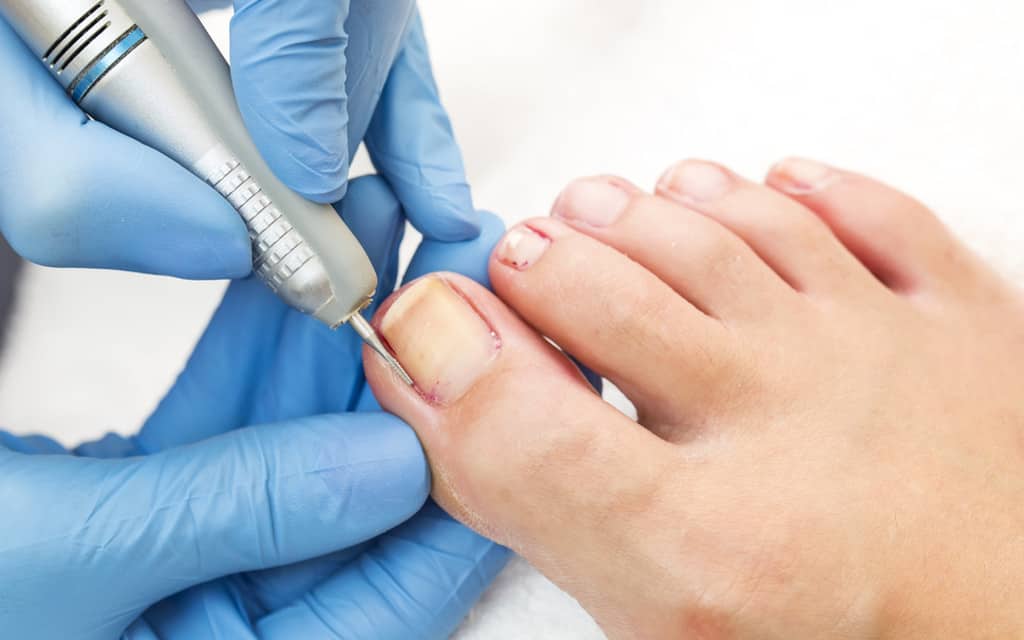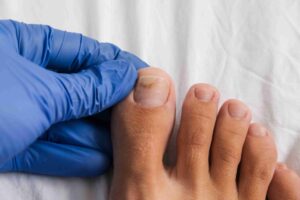Paola Ash - Best Toenail Specialist
Ingrown Toenail Treatments
What is an ingrown toenail?
Onychocryptosis or ingrown toenail is a usual pathology of the toenail component, mainly affecting teenagers and young adults. An ingrown nail comes from Greek word: ὄνυξ (onyx) ‘nail’ and κρυπτός (kryptos) ‘hidden’, and is a common form of nail disease. In French word, it is ongle incarné and in Italian, it is unghia incarnita. The ingrown toenail is in charge of disabling complaints like discomfort and difficulty in walking. It is linked with significant morbidity, hampering the quality of life as it affects sporting activities, work, or school. It principally occurs in the big toe (hallux).
Furthermore, Ingrown toenails account for about 20% of foot problems in primary foot care. The most frequently affected toe is the big toe. Also, ingrown big toenails happen most commonly in young men, and footwear and nail care habits are most often contributory factors.
What causes ingrown toenails?
You will have an ingrown toenail if you are:
- putting too much pressure on your toenails by wearing tight-fitting shoes, tights, or socks that clutter your toes
- injuring your toe such as by stubbing it
- cutting your toenails not straight across or too short
- having sweaty feet, which is easier for toenails to dig in as it makes your skin soft
- tear or pick the corners of your toenails
Furthermore, ingrown toenails are more common in older people, as nails get thicker as we age. They are also more prone to people who have circulation problems or diabetes. Ingrown toenails in diabetics should be treated with extra care, as the skin is very sensitive.
What are the Symptoms of Ingrown Toenail?
How to know if you’re getting an ingrown toenail? Ingrown toenails may result in pain all along the edge or at the end of the toe. Aside from localised pain, it may also show the following signs:
- Sore to touch
- Hot, tender and swollen area
- Pain is getting worse when under bed sheets or wearing shoes
- Hot, swollen and tender area
- As the condition gets worse, it may show redness and may be infected with increased pain
- In more serious cases, there may be oozing discharge present and growth of hypergranulation tissue
Even if these signs indicate an infected ingrown toenail, the symptoms may also be a result of a subungual corn, an involuted nail or just a thickened toenail. Hence, it is essential to get a precise diagnosis as wrong treatment could harm the toenail, worsen the pain and cause infections.
Risk Factors of ingrown toenails
There are many causes for ingrown toenails. Some of the risk factors include:
- Incorrect cutting practice – such as cutting your toenails too short or cutting the edges of the toenails which encourages the surrounding skin to fold over the nail, and the nail to then push into that piece of skin and pierce it.
- Slightly curved nails cause the nail to dig into the sides of your toes.
- Trauma to the nail – for instance, previous injury to the toenail such as kicking it on something hard or dropping something on the toe.
- Hereditary and genetic factors contributing to the shape of your toes or nails, which makes you more prone to getting ingrown toenails.
- Too much pressure from ill-fitting shoes which crowd your toenails and toes. This may include footwear that is too tight, short or narrow at the end.
- Sweaty feet – which makes the skin soft and will be easier for the toenails to dig in.
How to prevent Ingrown Toenails?
Prevention is the best treatment for ingrown toenails. Here are some habits you can do:
- Cut the nail in a right way – trim your toenails straight across from one corner to the other and avoid cutting down the sides of the nail.
- Maintain good, basic foot hygiene – clean the affected nail with antibacterial soap and apply an antiseptic regularly. Make sure the nail is covered and protected with a sterile dressing.
- Use correct fitting footwear – invest in shoes that are properly fit your foot which are not to wide and too narrow. You don’t want to put too much pressure from the footwear against the side of the nail.
- Avoid bathroom surgery – hacking away at your toenails yourself will only make your situation worse. Using unsuitable and non-sterile tools can lead to more damage or even infection of the affected nail.
Ingrown Nail Treatments – How to get rid of an ingrown toenail?
What are some ingrown toenail treatments that can help?
The normal care is currently on conservative treatment of an ingrown toenail like the gutter splint technique in the initial stages. Surgical correction is the treatment to choose in cases where they are resistant to medical management or recurrent.
How to fix an ingrown toenail? Non surgical ingrown toenail treatments like:
- soaking the foot in warm, soapy water;
- inserting dental floss or cotton wisps under the ingrown toenail edge; and
- gutter splint with or without the placement of an acrylic nail.
However, for conditions which have no signs of progress using the conservative procedures, surgical treatment will be suggested. Surgical methods include:
- Partial nail avulsion or complete nail excision with or without phenolization
- Radiofrequency
- Electrocautery
- Carbon dioxide laser ablation of the nail matrix
Even though there is no ideal procedure, lateral nail plate avulsion with lateral matricectomy by phenol is typically used and conveyed to be more effective in decreasing recurrences. Numerous ingrown toenail treatments can be discussed by a podiatrist near to you.
Ingrown Toenail Surgery Cost
Conclusions
Therefore, ingrowing toenail surgery carries a greater risk of postoperative infection compared to other procedures made by podiatric surgeons. Radical excision of the toenail bed was linked with higher postoperative infection rates than other ingrown toenail procedures. Procedures done in an office setting carry a greater risk of infection.
At the Chelsea Clinic we only recommend measures we have mentioned above for the present time. We are here to help you and to treat an infected ingrown toenail. Let us make you pain-free as soon as possible. Paola Ash, our main podiatrist, is a nail specialist who can assist with your toenail problem.
For more information call us ![]() at + 44 (0) 207 101 4000 or email us
at + 44 (0) 207 101 4000 or email us ![]() at info@thechelseaclinic.
at info@thechelseaclinic.
South Kensington Podiatrist – Toenail Specialist
Learn more about Plantar Fasciitis https://www.plantarfasciitisorthotics.co.uk/treatments/plantar-fasciitis
REFERENCES:
Alexander J. Terrill, Katie J. Green, Angelo Salerno & Paul A. Butterworth. Journal of Foot and Ankle Research volume 13, Article number: 48 (2020)
Indian J Dermatol Venereol Leprol. Ingrown Toenails. May-Jun 2012;78(3):279-89. DOI: 10.4103/0378-6323.95442.
Ngan Kim Harwood. INGROWN TOENAILS AND NAIL SURGERY eBOOK (2020)
EJ Mayeaux Jr, Charles Carter, Tenley E. Murphy. Am Fam Physician. Ingrown Toenail Management. 2019 Aug 1;100(3):158-164
Martínez-Nova A, Sánchez-Rodríguez R & Alonso-Peña D (2007). A new onychocryptosis classification and treatment plan. J Am Podiatr Med Assoc Vol 97: 389-93.
Tags: ingrown toenail treatment near me, nail specialist
FREQUENTLY ASKED QUESTIONS:
Will an ingrown toenail heal itself?
How to cut toenails to avoid ingrown?
How to know if you have an ingrown toenail?
How long for an ingrown toenail to heal?

Contact Us
Now offering home visits and online consultations
Tel: +44 (0) 207 101 4000 WhatsApp: +44 (0) 778 066 5223 Email: info@thechelseaclinic.uk
We now offer home visits and online consultations!
From the Blog

Is it a Green nail from Bacteria?
Is it a green nail from bacteria? What is Aspergillus Fumigatus (AF)? Is it a green nail from bacteria? Aspergillus Fumigates (AF) is a mould

Onychomadesis 101: Essential Information for Healthy Nails
Onychomadesis 101: Essential Information for Healthy Nails Onychomadesis is a condition where the nail separates from the nail bed, often leading to complete shedding

It might not just be a friction blister. What is Bullous Pemphigoid?
It might not just be a friction blister. What is Bullous Pemphigoid? Bullous Pemphigoid is an autoimmune skin condition that can cause painful blisters
